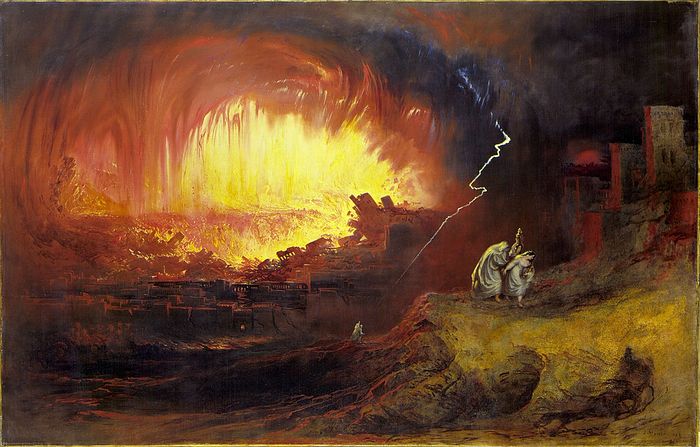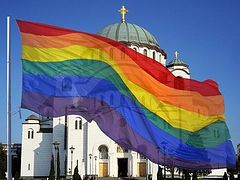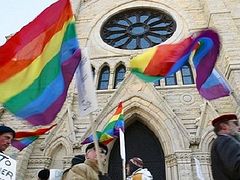In light of the confusion stirred in some readers of recent texts on Social Media and other online portals, regarding the Church’s clear teaching on homosexuality and the pastoral need to care for those suffering in particular from the social trend to regard it as “natural” or a thing to be accepted as part of human nature, the following text is provided for contrast. Presented as a “reference text” at a clergy meeting of the Russian Orthodox Church Outside of Russia in the USA last year, it offers a clear response to many of the social arguments used in the attempt to diminish the Church’s pastoral teachings, which always aim for the loving care and conversion of all who fall into any sin.
OrthoChristian.com is offering this in-depth report as a series of posts.
The entire PDF version of this article can be found here.
Introduction
Over the past 45 years, our society has undergone a revolution—there is really no other way to describe it—in the prevailing cultural attitudes towards homosexuality and various related “alternative” sexualities, an entire range of behaviors now collectively referred to by the acronym LGBTQ—Lesbian, Gay, Bisexual, Transgender, and Queer (this last term being a catch-all for identities and behaviors that do not fit into any of the preceding categories). Most of the contemporary population has come of age during this revolution. Older readers will remember a time when if such things were even mentioned, it was usually in the form of a tasteless joke, or in the context of an insult. Indeed, the behaviors associated with homosexuality were once criminally punishable in almost every jurisdiction—federal, state, and local—in the United States, and similarly abroad. To be “outed” credibly as someone who engaged in homosexual behavior usually meant that one’s reputation and career were ruined. Active homosexuals stayed carefully closeted, as they could become targets of blackmail or worse.
Today, not only does our society broadly tolerate homosexual behavior, it is legally recognized and given protected status. The US Supreme Court’s Obergefell decision in June of 2015 made the United States the 22nd country to officially recognize same-sex marriage. Homosexual characters are everywhere in television and films, and the attention of social progressives is moving towards the mainstreaming of ever more exotic sexual identities. Young people are growing up in an environment where casual acceptance of homosexuality and bisexuality is increasingly seen as the norm, and where dissenters from the new orthodoxy are regarded with contempt, not only as ignorant and unenlightened, but as positively evil.
This change in attitudes presents an array of challenges as we seek to live our lives as Christians. In some respects, the issues we face are similar to those of our brethren in late-classical antiquity. On the other hand, for them the norms of pagan sexuality represented a long-prevailing status quo, for which the Church was proclaiming a revolutionary alternative. For us, we face a newly remade moral landscape, and one which, far from being static, is evolving rapidly as it is driven forward by powerful social and political forces.
As we will necessarily discuss the biology and sociology of homosexuality, we will first ask, in advance, the pardon of any who are made uncomfortable by hearing medical—especially, anatomical—terminology, which will figure in certain sections. We will not go out of our way to offend; but neither will we substitute euphemisms for the usual scientific terms of art.
The “Four Core Beliefs” of Western Society about Homosexuality
The revolution described is based on the widespread acceptance in Western society of four (4) core beliefs. All these beliefs are asserted to be “scientific” in nature; the fourth is also a widespread cultural expectation. The campaigns of homosexual activists over the last 40 years have largely succeeded in institutionalizing this new understanding, and have created an all-embracing belief system that is aggressively defended against contradiction or skepticism from any quarter. The key elements of this belief system are as follows:
1) Homosexuals are born that way. Same-sex attraction (or if you prefer, sexual orientation) is innate, and largely genetically determined.
2) Same-sex attraction is immutable. Any attempt to reverse it entails a profound denial of self, and may result in mental problems such as depression, suicide, and alcohol and drug abuse. This is why homosexuals should be treated as a protected class, just as are racial and ethnic groups whose statuses are innate and immutable. Therefore, the proper role of psychiatry and psychology (and supporting social organizations) for those who are dissatisfied with their same-sex attraction is not to help them change—even if they wish to—but to help them to become comfortable with their homosexuality.
3) Homosexuality is normal. It is similar to other social categories such as race and ethnicity. Since, in this view, homosexuality is not an illness and is not pathological, it should be accepted and not discouraged in any way. Aside from sexual orientation, active homosexuals are just like everyone else.
4) Orientation equals behavior and self-identity. Once a person experiences same-sex attraction, that is who they are. It becomes their main identity—more important than religion, education, social class, ethnicity, personal interests, or anything else. They immediately become a part of the “LGBTQ community”, a subculture with clear expectations for their future behavior. In other words, if you experience same-sex attraction, you’re gay—and therefore expected to live a “gay lifestyle.” Any other way of life would be inauthentic and a denial of self, of “who you truly are.”
In this discussion, we will consider the extent to which these beliefs are true or not—and what insights the teachings of our faith can provide us.
We need first to have a thorough understanding of this phenomenon—historically, scientifically, and spiritually. So comprehensive has been the assault on the realties surrounding this issue that many Christians have been influenced by it, at least at the margins. For that reason, the “educational” portion of this discussion will be the most detailed and comprehensive. We will start with some historical and cultural observations.
Historical and cultural overview of the phenomenon
In beginning our discussion, we begin with a basic fact:
Human sexual behavior is almost completely mutable.
(We’ll consider the issue of attraction, or orientation, a bit later in the discussion.)
Sexual behavior is conditioned by cultural norms, by socialization, by personal experience, by religion, by philosophy—and to a minor extent, by certain biological factors. Human beings, in a fallen and unenlightened state, function polysexually.
With respect to the specific behavior under consideration, one ethnographic study found that 21 percent of the historical and contemporary cultures surveyed accepted or ignored homosexuality, 12 percent had no concept for it, 26 percent discouraged but did not punish it, and 41 percent strongly disapproved of and punished it.1
We will consider a few examples.
In the ancient world, attitudes towards homosexual behavior ranged from 1) the institutionalization of the behavior by society, to 2) fierce intolerance, and 3) everything in between.
That it existed, for example, among the Canaanites of the 21st century BC is evident from the familiar Biblical account of Sodom—whose name forms the root of our word, sodomy, for certain unnatural sexual practices.2
In China, homoerotic art exists from a number of periods in China’s long history. However, the Song Dynasty (11th century AD) criminalized homosexual prostitution; and in the 16th century the Qing Dynasty criminalized all homosexual intercourse. Literary references are more difficult to identify, since Chinese erotic poetry invariably employs elaborate metaphors when discussing sexual topics; it is often difficult to specify the gender specifics of the parties. Thailand, on the other hand, has had a long history of effeminate males, which in Thai society are sometimes regarded as a third gender.
In the New World, the Spanish conquistador Vasco de Balboa reported homosexual behavior among upper class natives of Panama.3 Among Plains Indian tribes, there existed the phenomenon of the so-called “two-spirited” person, typically a male with feminine behavioral traits. These individuals sometimes functioned as shamen, and interacted sexually with tribesmen of the same biological gender.4
The Greco-Roman world deserves more of our attention, both because it is often cited approvingly by contemporary homosexual activists, and more importantly, because it was into this environment that Christianity first emerged.
In classical Greece, a range of norms prevailed among the various city-states. The practice of pederasty is significant. This was a relationship intellectual, emotional, and sometimes sexual, between an adolescent youth and an older man, each pair consisting of an older erastês (ἐραστής, or “lover”) and a younger erômenos (ἐρώμενος, or “beloved”), both of whom would be citizens of approximately equal social rank. The prevalence of this practice varied widely by city and social class. The popular view of archaic and classical Sparta, that the city encouraged pederasty in the ranks of its soldiers, is probably incorrect; the only classical writer with first-hand experience of Spartan military training, Xenophon, explicitly denies it. Thebes, on the other hand, was known for its 4th-century “Sacred Band”, composed of 150 pairs of erastai and erômenoi, who served as elite troops for the city. The written record is most extensive for classical Athens, where many scholars argue that pederasty was an upper-class phenomenon, a form of mentoring and career sponsorship. Early in his career, Plato speaks approvingly of these relationships; in his later writings, he changes his view, describing them as unnatural and suggesting that they be banned. Aristotle, on the other hand, accepts them as a matter of course.
By contrast, homosexual relationships between adult men were considered inappropriate, especially for the “passive” partner, and were often an object of insult and mockery by comic writers.
It should be noted that these cultural practices and attitudes were rooted, in part, in a deep misogyny. Women in most Greek city-states were regarded as extreme inferiors. The existence of true love was considered impossible in the context of so unequal a relationship. As one classical scholar put it, “among Athenian upper class males, if you wanted children, you went to your wife; if you wanted sex, you went to a prostitute; if you wanted love, you went to a boy or youth.”5
There is less evidence for female homosexuality in the ancient world. The Greek archaic period poetess, Sappho of Lesbos (7-6th centuries BC), wrote much that is homoerotic in character, and in the process gave us our contemporary terms Sapphic and Lesbian. However, the character of her literary output is almost unique. Moreover, our knowledge of the lives of aristocratic women in archaic Greece is extremely limited; it is impossible to state, one way or the other, whether Sappho was bisexual or lesbian in the contemporary sense of those words.6
In general, among males in the Greco-Roman world a distinction was drawn between the active and passive partners in same-sex activity. Typically, the “active” (i.e., penetrative) partner was subject to little opprobrium, provided that his partner was of lower status: in general, non-citizens, by reason of sex or social class. This was particularly true—and highly characteristic—of late-Republican and early-Imperial Roman mores. An adult male Roman citizen could function in a dominant sexual role with any non-citizen—slave, freedman, performer, or prostitute—without comment. On the other hand, in contrast to the Greek pattern, young male citizens were strictly off-limits, as the passive role was seen as demeaning to the youth’s social status. In the Roman army, in striking contrast to Greek—and now contemporary Western—views, homosexual conduct between soldiers was severely punished as a serious breach of military discipline.
Significantly, the question of orientation was non-existent; there are no classical Greek or Latin counterparts to our contemporary concepts of homosexuality and heterosexuality in English.7
As one would expect, Roman mores changed steadily after the adoption of Christianity by St. Constantine, with a steadily increasing discrimination against homosexual practices. According to Zonaras (Book III), both Theodosius the Great and St. Justinian condemned sodomites to forfeiture of possessions and severe punishments. In the Roman East, proscriptions against homosexual conduct became fully institutionalized in law by 618 AD.
Islamic cultures, although sharing the proscriptions against homosexuality of other Abrahamic religions, have as a matter of practice taken the view that penetrative intercourse is not effeminate, and that only the passive partner is “homosexual.”
A full anthropological survey of this phenomenon is beyond the scope of this discussion. However, there are three (3) principal observations to be made from even a cursory historical overview. First is the relative scarcity of evidence, empirically, for biological determinism as a principal factor (unless, perhaps, it is simply to observe that fallen man is capable of anything). Behaviors, as we have observed, vary widely from culture to culture. Second is the relative lack of identity as an element in most ancient cultures where homosexual behavior was widely practiced. There are few parallels to contemporary Western society, where orientation and identity are front and center. And third is the importance of accepted social norms in conditioning sexual behavior. We will discuss all of these, as we continue.
The Teachings of the Church: the Judeo-Christian Tradition
In the preceding survey, we have not yet considered the example of Old Israel, and referred only in passing to the influence of Christianity on the later Roman Empire—in part because they are exceptional, but principally because the testimony of the Church stands apart from all merely human history, as inspired by the oracles of God. While certain cultures, building only on their natural knowledge of God, have in various times and places embraced chastity as an ideal, it is only in the teaching of the Church that we find this understanding elevated to a cardinal virtue. Most are all familiar with the relevant citations in Scripture, so they will not be enumerated in detail. However, it should be noted, that while these may be to most conservative Christians self-evident truths, the preceding historical survey suggests how “revolutionary” and transformative they were to the life of fallen man.
The people of God—the patriarchs and Old Israel—had definite views about which sexual behaviors were permissible and which were not, by which they stood out from among the peoples of ancient Canaan. The revelations to the Israelites, from the Law of Moses, were direct and specific:
From Leviticus in chapter 18 [22, 30]:
You shall not lie with a male as with a woman; it is an abomination . . . defile not yourselves therein: I am the Lord your God.
The 20th chapter of the same book goes so far as to make such behavior a capital crime [13]:
If a man lies with a male as with a woman, both of them have committed an abomination; let them be put to death: their blood is upon them.
And similarly, in Deuteronomy [23:17]:
There shall be no whore of the daughters of Israel, nor a sodomite of the sons of Israel.
In the Old Testament histories, the books of the Kings, we find King Rehoboam criticized because he permitted sodomites in Judah, and King Asa praised because he drove them out.
The views of the New Testament writers were consistent with their Old Covenant forbearers. The Apostle Paul, in his letter to the Romans [1:22-27], comments:
Professing themselves to be wise, they became fools . . . Wherefore God also gave them up to uncleanness through the lusts of their own hearts, to dishonor their own bodies between themselves . . . women exchanged natural relations for those that are contrary to nature; and the men likewise gave up natural relations with women and were consumed with passion for one another, men committing shameless acts with men and receiving in themselves the due penalty of their error.
In his first letter to the Corinthians [6:9-10], he writes further:
Do not be deceived: neither the sexually immoral, nor idolaters, nor adulterers, nor men who practice homosexuality, nor thieves, nor the greedy, nor drunkards, nor revilers, nor swindlers will inherit the kingdom of God.
And in his first letter to Timothy [1:9-10a]:
Knowing this, that the law is . . . made . . . for the lawless and disobedient, for the ungodly and for sinners . . . for whoremongers, for them that defile themselves with mankind . . .
In the General Epistle of the Apostle Jude [7], we read:
Sodom and Gomorrah, and the surrounding cities, which likewise indulged in sexual immorality and pursued unnatural desire, serve as an example by undergoing a punishment of eternal fire.
Christianity emerged into the world of late-classical antiquity with a radical, life-transforming alternative to the worldview of pagan society. Among these new, life-changing virtues was a chaste life as the aim of every faithful Christian. The Apostle Paul alludes to this in his first letter to the Corinthians [6:11]:
And such were some of you. But you were washed, you were sanctified, you were justified in the name of the Lord Jesus Christ and by the Spirit of our God.
And again, in his letter to the Colossians [3:5-8]:
Put to death therefore what is earthly in you: sexual immorality, impurity, passion, evil desire, and covetousness, which is idolatry. On account of these the wrath of God is coming. In these you too once walked, when you were living in them. But now you also put off all these.
Note that these verses make clear that among the Christians in Corinth and Colossae were people who had led sexually immoral lives prior to their conversion to Christianity. Corinth, in particular, in both classical and apostolic times, was notorious for its sexual immorality.8
The Holy Fathers of the first centuries of Christianity bluntly describe the world they sought to transform. St. Cyprian of Carthage writes:
“Oh, if placed on that lofty watch-tower, you could gaze into the secret places—if you could open the closed doors of sleeping chambers and recall their dark recesses to the perception of sight—you would behold things done by immodest persons which no chaste eye could look upon; you would see what even to see is a crime; you would see what people imbruted with the madness of vice deny that they have done, and yet hasten to do—men with frenzied lusts rushing upon men, doing things which afford no gratification even to those who do them.”—St. Cyprian of Carthage, “Letters” c. 250 AD.
St. John Chrysostom writes:
“All of these affections [in Rom. 1:26-27] . . . were vile, but chiefly the mad lust after males; for the soul is more the sufferer in sins, and more dishonored than the body in diseases. The sins against nature are more difficult and less rewarding, since true pleasure is only according to nature. But when God abandons a man, everything is turned upside down! . . . A murderer only separates the soul from the body, whereas these destroy the soul inside the body . . . There is nothing, absolutely nothing more mad or damaging than this perversity.”—St. John Chrysostom, “Homilies on Romans”.
And in words that surely must seem, to us, prophetic, St. John in another place writes:
“The worst of it is that such an abomination is committed boldly and that the monstrosity becomes the law. Nobody nowadays fears, nobody blushes. They boast and they laugh at these actions. The people who abstain appear stupid and they who condemn are regarded as fools. If they appear to be weaker they are crushed with blows. If they are stronger, people laugh, people mock them and make many jokes about them. They have no redress in tribunals or in law.” (Against the Opponents of Monastic Life, III.8)
Perhaps there is also some consolation here for us that the worldly attitudes against which St. John preached sound so familiar to us.
Concerning those in Holy Orders who fall into these sins, Saint Basil the Great writes:
“The cleric or monk who molests youths or boys or is caught kissing or committing some turpitude, let him be whipped in public, deprived of his tonsure, and () reduced to eating rye bread once a day in the evening three times per week. After six months living in a separate cell under the custody of a wise elder with great spiritual experience, let him be subjected to prayers, vigils and manual work, always under the guard of two spiritual brothers, without being allowed to have any relationship . . . with young people.” (St. Basil the Great, in St. Peter Damien, Liber Gomorrhianus)
We find similar comments in St. Clement of Rome, in St. Aristides, in the Epistle of St. Barnabas, in Blessed Augustine and in Tertullian.
The early Canons of the Orthodox Church also speak to these practices:
From the 92 Canons of St. Basil (affirmed specifically by the 4th, 6th, and 7th Ecumenical Councils):
Canon 7:
“Sodomists and bestialists and murderers and sorcerers and adulterers and idolaters deserve the same condemnation, so that whatever rule you have as regarding the others observe it also in regard to these persons.”
Canon 62:
“As for any man who uncovers his nakedness in the midst of males, he shall be allotted the time [i.e., 15 years] fixed for those transgressing in the act of adultery.”
From the 35 Canons of St. John the Faster:
Canon 9:
“As for sexual intercourse of men with one another, such as practicing double masturbation, it received the stated penance of up to eighty days [together with strict fasting and one hundred prostrations a day].”
It should be noted that the canon for double masturbation is precisely twice the penance prescribed for solo masturbation in the preceding Canon 8 because, as St. Nicodemos of the Holy Mountain notes: “Each of these offenders is not only hurting himself, but is also hurting his brother, and this makes the sin a double sin” (The Rudder, p. 938).
Canon 18:
“It has seemed advisable to exclude any man who has been so mad as to copulate with another man from Communion for three years, weeping and fasting, and towards evening confined to xerophagy [i.e., a strict vegan raw diet], and doing two hundred prostrations. But as for one who prefers to take it easy, let him fulfill the fifteen years [i.e., of Canon 62 of St. Basil].”
We see in these Canons a number of things. The first is that, as in Scripture and the writings of the Fathers, unnatural acts are regarded with great seriousness. Second, that the act of anal sodomy is regarded as a much greater fall than certain other homosexual behaviors; and third, that even anal sodomy is grouped with a number of other sexual sins, such as adultery. This has some significance for us, since in the context of this country’s “culture wars,” it is easy to fall into the trap of regarding temptations of this kind as a kind of “ultimate sin,” rather than as one of a number of related passions against which man in his fallen state must struggle.
However, this perspective does not extend to a view that “fornication is fornication” (i.e., regardless of whether it is same-sex or opposite-sex). It is clear from the canons and writings of the Fathers, that homosexual fornication, at least in the context of anal sodomy, is regarded as more serious than heterosexual fornication, just as adultery is so regarded.9
In summary, an enormous weight of Scripture, together with the Holy Fathers and the Holy Canons, fences us from homosexual behavior. That our loving Lord, Who is love (1 John 4:8), and desires that we might have life, and that . . . more abundantly (John 10:10), so directs, gives unassailable witness to the destructiveness, of both soul and body, of these behaviors. Some reasons why this is so will become plain during the portion of the discussion on the science of homosexuality.
St. Paul urges us to be not conformed to this world: but be ye transformed by the renewing of your mind, that ye may prove what is that good, and acceptable, and perfect, will of God. (Romans 12:2). The word translated here as “world” is not the usual κοσμός (“kosmos”), the material world, but αιώνι (“aioni,” eon or time)—the age in which we live. And this is our challenge as Christians, that we not allow ourselves to be conformed to this age, but to the will for us of our loving Lord.
This understanding—that unnatural sexual relations are destructive of soul and body, and therefore to be discouraged—was universal in the Christian world for the next 1300 years.
Next: The Process of Change in the United States







https://02varvara.wordpress.com/2016/07/02/2-july-2016-is-there-a-gay-agenda-i-think-not/
2nd quote:
"So, to say that there’s a “Gay Lifestyle” is just ideological propaganda, generally laced with hate, fear, malice, and (often enough) a “cover-up” for one’s own shameless “behind the scenes” activities.
We don’t accept same-sex marriages in the Orthodox Church, but many Orthodox communities embrace gay Orthodox Christians with openhearted love and recognition of their humanity.
One can’t defend truth with lies nor can one defend the faith with slanders, wilful falsehoods, hate, malice, and anger.
I’ve carefully studied more than a hundred careful, well" ...
https://02varvara.wordpress.com/2016/07/02/2-july-2016-is-there-a-gay-agenda-i-think-not/
1st quote:
"Some people asked me if I actually thought that there was a “Gayagenda”.
No, of course, I don’t believe that. Nor is there any such thing as a “Gay Lifestyle”.
That’s just part of the usual rightwing detritus, and few forces in our world today are as fraudulent and evil as rightwingers… i.e., ISIS is a rightwing movement.
One of the most dangerous things in our world today is the Rightwing Agenda, especially, its war against the knowledge of and action against global warming and climate change." ...
From a personal standpoint, I am a single, heterosexual and am living chastely, which unfortunately to a lot of today's society means I must be gay. The point for me here is not centered on defending my situation, but rather to further indicate an erosion of what passes for truth, knowledge, respect, etc., concerning many social topics.
The Song Dynasty began in the 10th Century when it was founded by honorable general Zhao Kuang Ying in 960 AD.
The beginning political origin of normalization began as always in academia [including international level] response to War conflict, Kinsey, Masters & Johnson - the point of disease risk attached to unnatural behavior – which was for a time excluded in the earliest League of Nations/United Nations injection of secularist morality as a 'psychological' human right. Unfortunately for the world without medical translation and resultant global epidemic of cancers and HIV AIDS:
Epidemic pre pubertal boy sexually transmitted disease [STDs] aside of syphilis and gonorrhea leading to fatal anal cancer, AIDS
e.g. Shigella sonnei, Shigella flexneri, Campylobacter enteritis, Campylobacter jejuni, or Salmonella enteritis; intestinal parasites such as Giardia lamblia, Entamoeba histolytica, and Entamoeba coli; herpes simplex and Chlamydia trachomatis. God's blessings on the dialog.
Thank you.
An Outline Guide Based on Scripture and Christian Tradition." This piece unpacks the *logic* behind Christian sexual morality, going forward from Genesis, and contains a great deal of Scripture. You will find it at http://scienceetcetera.blogspot.com/p/religion.html I hope that it still proves helpful to some.
God created Man and Woman. Homosexuality is an Abomination to GOD. No compromising GOD or Sin.
My main problem with this Article has nothing to the subject of Homosexuality, but the statement that Constantine so called "Adopted Christianity" which he never did.
Christianity always was and to this day and existed Long before Emperor Constantine made it a State Sponsored Religion. Greece & Rome were PAGAN.
The Book of John was written years before Constantine created both Legs of the EASTERN and Western Church and both the Orthodox, and Roman Catholic are both incorrect on this 1 True Church concept.
All believers in Christ are his Church.
Thank You.
https://www.youtube.com/watch?v=0m8-_QlwYV8